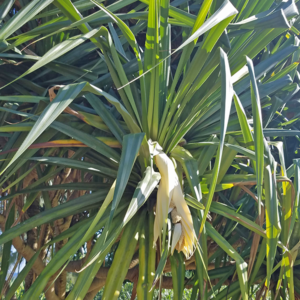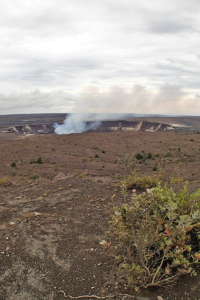Niuli‘i update
 November 2021—We are grateful for the mo‘olelo and ideas shared by the kupaʻāina of Niuliʻi as important guides for future hana to preserve the pūhala (hala trees) and surrounding ‘āina entrusted to us by the community. Spending time in the ancient ulu hala (hala grove) to clear invasive weeds and lauhala (hala leaves) buildup around the ulehala (hala roots), removing palahō (dried) leaves from the canopy, and practicing kilo are feeding our relationship with ʻāina. Over time, we hope to recognize seasonal and cyclical changes to inform respectful ‘āina stewardship practices. Contact Mia Akau-LaClair, community and resource relations manager, for more information.
November 2021—We are grateful for the mo‘olelo and ideas shared by the kupaʻāina of Niuliʻi as important guides for future hana to preserve the pūhala (hala trees) and surrounding ‘āina entrusted to us by the community. Spending time in the ancient ulu hala (hala grove) to clear invasive weeds and lauhala (hala leaves) buildup around the ulehala (hala roots), removing palahō (dried) leaves from the canopy, and practicing kilo are feeding our relationship with ʻāina. Over time, we hope to recognize seasonal and cyclical changes to inform respectful ‘āina stewardship practices. Contact Mia Akau-LaClair, community and resource relations manager, for more information.

 August 2021—Tūtū Pele provided researchers from the Department of Civil and Environmental Engineering at the Massachusetts Institute of Technology with a valuable learning opportunity to test low-cost sensors that could benefit communities worldwide to measure, track, and inform residents about local air quality. Dr. Elizabeth Cole and Ilene Grossman from The Kohala Center collaborated with the MIT team and researchers from the School of Ocean and Earth Science and Technology at the University of Hawai‘i at Mānoa to co-author “
August 2021—Tūtū Pele provided researchers from the Department of Civil and Environmental Engineering at the Massachusetts Institute of Technology with a valuable learning opportunity to test low-cost sensors that could benefit communities worldwide to measure, track, and inform residents about local air quality. Dr. Elizabeth Cole and Ilene Grossman from The Kohala Center collaborated with the MIT team and researchers from the School of Ocean and Earth Science and Technology at the University of Hawai‘i at Mānoa to co-author “